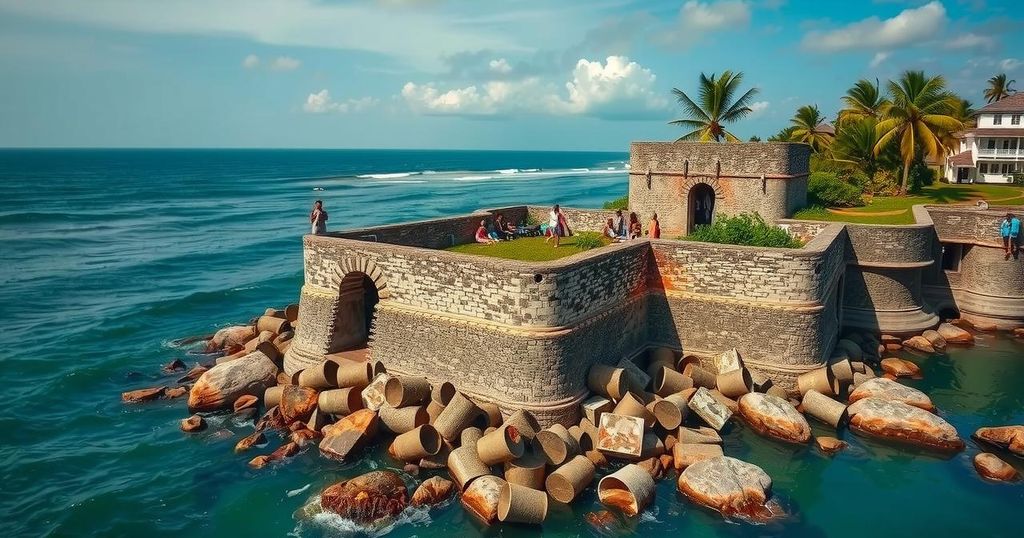Ghana’s Historic Coastal Forts Under Threat from Climate Change
Ghana is losing its historic coastal forts due to climate change and rising sea levels, with communities facing extinction from tidal waves. Fort Prinzenstein and Fort Kongenstein are among those significantly affected, while initiatives like the Keta Sea Defence Wall and the West Africa Coastal Areas Resilience Investment Project aim to address coastal erosion and protect ecosystems.
Ghana is facing a significant loss of its historic coastal forts due to the escalating effects of climate change, particularly intense tidal waves along its 550-kilometer coastline. This gradual erosion poses risks not only to these historical structures but also threatens the very existence of numerous coastal communities. Annually, an estimated two meters of coastline are lost to erosion, with some areas suffering from losses as extensive as 17 meters, as per a study conducted by the Institute for Environment and Sanitation Studies. The increasing sea levels, attributed to climate change, endanger the livelihoods of vulnerable communities situated in low-lying regions, as well as the preservation of Ghana’s renowned slave forts and castles. Among the structures most at risk is Fort Prinzenstein, established over 240 years ago in Keta, Volta Region. Once a robust fortress, it has succumbed to the relentless waves that have destroyed approximately two-thirds of the fort, as noted by James Ocloo Akorli, the fort’s caretaker. He lamented, “Eight of its ten dungeons, originally built to hold enslaved Africans during the trans-Atlantic slave trade, were completely submerged before a sea defense wall was erected to protect what remains of the monument.” Further along the coast, Fort Kongenstein, an 18th-century relic located in Ada, was unable to withstand the onslaught; today, its previous location is entirely underwater. Similarly, Fort Fredensborg in Old Ningo has diminished dramatically, leaving behind only a vestige of what was once a fortified armory. Joyce Ayorkor Guddah, the Tourism and Culture Officer in Ningo Prampram district, remarked, “Fort Vernon has become a death trap, as the tidal waves have severely damaged it.” The plight of coastal communities is equally distressing. Many areas, such as Fuveme, have been entirely washed away. Former resident Akorli Simon recounted, “the Sea began swallowing our community. We were devastated and had to abandon Fuveme in 2016 after a powerful tidal surge washed away the land.” The displaced population has since sought refuge in the neighboring village of Dzakplagbe, though there are fears that this location may meet a similar fate. The consequences are similarly dire in the Western Region, where Anlo village has been reduced to a mere strip of land caught between surging tides and the expansive lagoon. In Accra, the suburb of Glefe has also seen many residents flee due to the destruction wrought by tidal waves. In response to these escalating challenges, significant interventions are underway. A key project is the construction of the 8.3-kilometer Keta Sea Defence Wall, initiated over a decade ago with a funding boost from the United States Export-Import Bank at a cost of $94 million. Furthermore, the World Bank has financed the West Africa Coastal Areas Resilience Investment Project, Ghana 2, to the tune of $155 million, with a vision to bolster coastal resilience and protect vital ecosystems in regions such as Korle Lagoon, Densu Basin, and Keta Lagoon.
Ghana’s coastline has enough historical significance, particularly with the presence of forts that played a crucial role in the trans-Atlantic slave trade. However, these structures are now under threat due to advancing climate change, including rising sea levels and intensified tidal waves. The loss of these forts signifies not only a cultural and historical calamity but also presents existential challenges to the coastal communities that have thrived for generations. Efforts are being made to mitigate the impact of coastal erosion through the construction of sea defense walls and various environmental projects, yet the situation remains precarious.
In summary, Ghana faces a formidable challenge as climate change leads to the alarming erosion of its historical forts and threatens the existence of coastal communities. Despite the ongoing initiatives to combat this crisis, the risk posed by rising seas and tidal waves necessitates urgent action and sustained efforts to protect both cultural heritage and the livelihoods of affected populations.
Original Source: www.rfi.fr




Post Comment